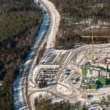For sustainable nuclear energy, a closed fuel cycle
By Baldev Raj, P.R.Vasudeva Rao, April 9, 2015
Reprocessing and recycling uranium and plutonium have been a matter of intense debate in many countries over the last few decades. A number of nations—including the United States, the United Kingdom, France, India, Japan, Russia, and others—have developed technologies for reprocessing and recycling. A select group of nations, including India, have followed a sustained policy in favor of reprocessing and recycling. They have pursued these policies not only out of concern over limited uranium resources, but also because they see reprocessing and recycling as the best path toward making nuclear energy sustainable over the long term.
Indeed, for countries such as India and China, large-scale expansion of nuclear energy is not sustainable without reprocessing and recycling. These countries' uranium resources are limited. Thorium seems unlikely to become a valuable resource for energy production in the near term. It is impractical to manage large volumes of high-level waste in repositories for long periods of time. Elsewhere, France has also had a sustained program for reprocessing and recycling, and Russia is pursuing pyroprocessing to produce plutonium-uranium mixed oxide fuel for its BOR-60 reactor.
Many critics of reprocessing believe that the world's available resources of uranium are adequate—and that closing the fuel cycle is therefore not an urgent necessity. This is a short-sighted argument. The quantity of uranium available on Earth—either in the planet's crust or in the waters of the oceans—is finite, and fission energy is therefore not renewable. The only debate about this question can concern how much uranium is available and how long it will last. The "Red Book" of uranium resources, produced by the International Atomic Energy Agency and the Nuclear Energy Agency, indicates that the world's available uranium as of 2013 amounted to about 7.6 million metric tons—enough to last for about 150 years at current rates of consumption. Consumption, though, is bound to increase as an increasing number of countries turn to nuclear energy to meet their energy requirements.
Putting aside additional uranium resources that may be identified in the future, and also putting aside nuclear energy's future growth rate, one must conclude that uranium-based fission energy cannot in any event last for more than a few centuries. This is not much time—when measured against the length of time that humankind is likely to exist. We, the authors, believe that the current generation bears a responsibility toward future generations not to deplete the world's uranium resources. This means that uranium cannot be discarded as waste after only 1 percent of its energy is utilized—as happens today. Rather, reprocessing and recycling must be pursued so that 75 percent of uranium (if not more) is used to produce fission energy. Reprocessing and recycling have the potential, compared to the once-through use of uranium, to increase by a factor of at least 50 the amount of time during which humankind can derive fission energy from uranium resources.
Several countries—India, France, Russia, and China in particular—have concluded that fast reactors (which can exploit for electricity generation the plutonium and depleted uranium generated in thermal reactors) will be an important element of their future nuclear power programs. And of the six concepts for innovative nuclear energy systems being developed by the Generation IV International Forum (a collective undertaking of 13 governments), four are based on fast reactors. But arguments against reprocessing and recycling continue to be made.
These include—in addition to the argument that uranium resources will remain adequate for the foreseeable future—the supposed immaturity of the technology, its perceived high cost, and proliferation considerations. But the technology surrounding fabrication and recycling of reactor fuel is in fact mature, and has already been developed on a reasonably large scale (though only in a handful of countries). France and India—through extensive research and development, stable government policy, and successive implementation of improved plants—have demonstrated the safety, maturity, and acceptable cost of reprocessing and recycling of plutonium. Meanwhile, resistance to proliferation can easily be built into the design of the fuel cycle. It is possible to envisage separation schemes in which uranium and plutonium from irradiated fuel are recovered together—and no pure plutonium product, which might cause proliferation concerns, is produced. Pyroprocessing, for example, which has undergone considerable research in the United States and Russia, achieves less decontamination of fission products than the aqueous processes based on the PUREX method (for plutonium uranium extraction), which have been the mainstay of the nuclear industry to this point. This provides inherent proliferation resistance. Proliferation concerns no longer constitute a convincing rationale for adopting a once-through fuel cycle.
The waste dimension. Management of nuclear waste is the single dimension of nuclear energy on which the public focuses most. The once-through fuel cycle presents two serious problems in this regard. First, because the once-through cycle involves disposing of uranium and plutonium as waste after only one use, a larger volume of waste results. This creates a greater need for repositories and an impractically long time period over which they need to be monitored—which the public is never likely to welcome. Second, a significant number of countries are establishing nuclear power sectors today, but most nations are not endowed with sites geologically appropriate for disposal of irradiated fuel. Who, then, will bear the burden of the spent fuel that these new nuclear power facilities generate?
Such issues must be taken into account when the cost of various approaches to the fuel cycle is calculated. Usually, recycling's cost is compared with the cost of the once-though cycle under the assumption that uranium will remain at its current cost. But even assuming that uranium's price stays stable for centuries—unlikely—one still must account for the once-through cycle's higher waste management costs. One must also account for the extra environmental harm associated with the greater mining requirements of the once-through cycle—if uranium and plutonium are recycled, less uranium needs to be mined per unit of energy produced. This sort of holistic approach to cost shows that reprocessing is not prohibitively expensive, as it is often portrayed, but in fact is cost-competitive.
Topics: Nuclear Energy, Nuclear Weapons
Share: [addthis tool="addthis_inline_share_toolbox"]














